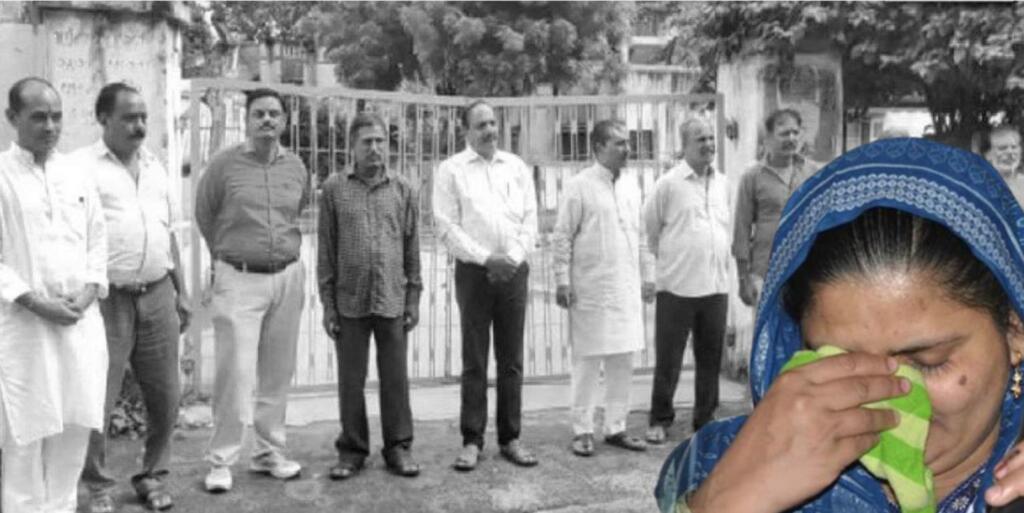Today, I don’t speak as a journalist, rather, I speak as a woman, addressing every woman out there, or every person reading this. Women, as a gender, are at the risk of the most intimate of crimes, that is, rape. Crimes against women are not limited to any territorial jurisdiction. The Indian legal system logs rape as “non-bailable offence”. But, the conscience of the country is shaken when the ones guilty of such brutal anti-humanity crimes go scot free.
Release of Bilkis Bano’s rapists is revolting
Wide Scale protests were registered across India after the Gujarat government decided to free 11 men, convicted of raping Bilkis Bano. The Gujarat government had released the 11 convicts through remission on the occasion of Azadi ka Amrit Mahotsav, after they had completed more than 15 years in jail, on the grounds of “good behaviour”. The 11 men were sentenced to life imprisonment in 2008. The Supreme Court of India, on August 26, issued a notice to the Gujarat government regarding the same.
Bilkis Bano is a woman who has suffered from a rarest of rare crimes. No one can imagine how daunting it would be for her to know that the men who raped her are walking freely on the streets. Men guilty of committing such a heinous crime walking free is simply like criminals getting an incentive for their crimes. That would further encourage them as well as others to commit such crimes.
Bilkis Bano: Not a lone case
There is widespread anger across the nation regarding the release of these convicts. But the case of Bilkis Bano is not a lone case. Rather, ‘Bilkis’ could be any face in the crowd, and the crime could come in many forms. ‘Bilkis Bano’ today stands as a name that represents the hundreds and thousands of women who have been exploited or violated.
In the infamous Kerala nun rape case, Bishop Franco Mulakkal was acquitted while the nun is forced to live the rest of her life under isolation and threats. Not only the patriarchal regime of catholic churches but the entire political cabal tries to shield the priest.
The Supreme Court in April this year, not only refused to hang him for his heinous crime but also commuted the death sentence of a man named Mohd Firoz convicted of raping and killing a 4-year-old girl. The court, adopting a humanitarian gesture, believed that every human should get an opportunity to improve. These cases are just the tip of the iceberg and the rot runs deeper.
How human rights end up providing cover for criminals
Every individual deserves an opportunity to become someone who would benefit society in the future. This is what the law believes, it considers every human to be divine, who deserves an opportunity to correct his or her past sins.
However, this does not stand true for every individual. If this would have been so, then the accused/convicts must have committed crimes when out on bail. Hundreds of arrests have been made, as prisoners returned to crime while they were out on bail. Be it any committee or court of law, it cannot guarantee a change of heart of a convict as we are just animal species finding ways to cut through an existential crisis. And barbarism is an innate nature of the human psyche.
In most cases, the use of human rights ends up providing state protection to the criminals. The lethal combination of human rights and restorative justice doctrine ends up shielding the criminals, while the victims are left on their own. This further weakens the trust of people in the system and creates panic.
How the release of convicts paints a wrong picture of Bharat?
The foremost goal of any civilisation should be the protection of women and children. And the civilisational state of India holds no different values other than this. However, the excessive use of the doctrine of human rights is slowly drifting us away from this goal.
India has a rich history of protecting women and their dignity. We have even recorded the history of “Vadh” performed for the same. Hindu scriptures like Ramayan and Maharbharat have ample examples of this.
The cultural history of Bharat, which advocates for protecting the rights and dignity of women, would never approve of such a lethal mixture of human rights and restorative justice being practised at the mental sanity of the victim.
Most of the victims who have been violated don’t fight or yell. But some do, for bringing the culprits to justice. As if someone who has put up a brave fight has just started to heal would feel listening that the men who brutally violated her will be roaming around freely on the same streets on which the heinous crime took place.
To add on, watching the rapists’ freedom being celebrated, they being garlanded, felicitated puts a simple question in front of us, ‘Do the women around us, actually matter?’
Support TFI:
Support us to strengthen the ‘Right’ ideology of cultural nationalism by purchasing the best quality garments from TFI-STORE.COM
